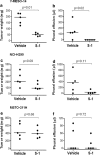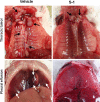The therapeutic efficacy of S-1 against orthotopically implanted human pleural mesothelioma cells in severe combined immunodeficient mice
- PMID: 21079960
- PMCID: PMC3143341
- DOI: 10.1007/s00280-010-1503-x
The therapeutic efficacy of S-1 against orthotopically implanted human pleural mesothelioma cells in severe combined immunodeficient mice
Abstract
Purpose: Malignant pleural mesothelioma (MPM) is a highly lethal neoplasm. S-1 has been developed as a novel oral antineoplastic agent based on the modulation of 5-fluorouracil (5-FU) bioactivity. This study was conducted to investigate the preclinical therapeutic effect of S-1 on MPM.
Methods: We used three human MPM cell lines, Y-MESO-14, NCI-H290 and MSTO-211H. In vitro proliferation of human MPM cells was determined by MTT assay. Human MPM cells were orthotopically implanted into thoracic cavity of SCID mice. Tumor-bearing mice were treated with S-1 or vehicle.
Results: The combination of 5-FU and 5-chloro-2,4-dihydroxypyridine (CDHP) was more effective than 5-FU alone in inhibiting MPM cell proliferation in vitro. This combination was most effective in Y-MESO-14 cells, which co-expressed high protein level of dihydropyrimidine dehydrogenase (DPD) and thymidine phosphorylase (TP). In vivo data showed that treatment with S-1 significantly reduced thoracic tumors and pleural effusion produced by Y-MESO-14 cells. Moreover, treatment with S-1 prolonged the survival of Y-MESO-14 cell-bearing SCID mice.
Conclusions: We demonstrated that S-1 was effective for inhibiting the proliferation of MPM cells, particularly with both DPD and TP expressions, suggesting that S-1 might be therapeutically effective for control of MPM.
Figures






References
Publication types
MeSH terms
Substances
LinkOut - more resources
Full Text Sources
Medical

